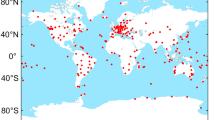Abstract
This paper investigates tilt decorrelations due to atmospheric anisoplanatism occuring when observing wavefronts emerging from distinct line of sight. The targeted application is ultimately the (pre-)compensation of the atmospheric turbulence experienced by a laser beam during ground-to-satellite optical links. The purpose of the study is to evaluate the effectiveness of the uplink pre-compensation, if the downlink signal (received from the satellite) is used as a reference. Because of the point-ahead angle of the satellite, one expects some decorrelation between the downlink and the uplink signals, which, in turn, impacts the efficacy of the pre-compensation. The larger the beam, the smaller its divergence and the more sensitive it is to pointing errors. In this framwork, a test campaign was carried out in May 2018 at the Optical Ground Station (OGS) of the European Space Agency (ESA), to perform measurements of double stars featuring angular separations representative of the point-ahead angle of GEO/LEO satellites. The differential Tip/Tilt distortion between the double stars is used as an estimator of the typical decorrelation between the downlink and the uplink signal, hence the present study. The algorithm used to extract the tip-tilt error due to anisoplanatism is described, and the experimental results are compared to the numerical predictions. It is then shown how to estimate the jitter of the telescope, based on the common motion of two independent stars as seen in the focal plane of the telescope. Finally, the paper provides a methodology to determine the maximum transmitter aperture of a ground-based terminal, in case a tilt pre-compensation is applied based on the satellite signal.








Similar content being viewed by others
References
Henniger, H., Wilfert, O.: An introduction to free-space optical communications. Radioengineering 19(2), 203–212 (2010)
Belmonte, A., Taylor, M.T., Hollberg, L., Kahn, J.M.: Effect of atmospheric anisoplanatism on earth-to-satellite time transfer over laser communication links. Optics Express 25(14), 15676–15686 (2017)
Foy, R., Labeyrie, A.: Feasibility of adaptive telescope with laser probe. Astron. Astrophys. 152, L29–L31 (1985)
Mata-Calvo, R., Calia, D. B., Barrios, R., Centrone, M., Giggenbach, D., Lombardi, G., Becker, P., Zayer, I.: Laser guide stars for optical free-space communications. In: Free-Space Laser Communication and Atmospheric Propagation XXIX, vol. 10096, p. 100960R. International Society for Optics and Photonics (2017)
Beland, R.R.: Propagation through atmospheric optical turbulence. Atmos. Prop. Radiat. 2, 157–232 (1993)
Giggenbach, D.: Optimierung der optischen Freiraumkommunikation durch die turbulente Atmosphäre - FocalArray Receiver, PhD thesis, Universität Der Bundeswehr München (2004)
Comeron, A., Dios, F., Rodriguez, A., Rubio, J. A., Reyes, M., & Alonso, A.: Modeling of power fluctuations induced by refractive turbulence in a multiple-beam ground-to-satellite optical uplink. In: Free-Space Laser Communications V, vol. 5892, p. 58920O. International Society for Optics and Photonics (2005)
Fried, D.L.: Optical resolution through a randomly inhomogeneous medium for very long and very short exposures. J. Opt. Soc. Am. 56, 1372–1379 (1966)
Fried, D.L.: Anisoplanatism in adaptive optics. J. Opt. Soc. Am. A. 72, 52–61 (1982)
Sasiela, R.J.: Electromagnetic wave propagation in turbulence: evaluation and application of Mellin transforms, vol. 18. Springer Science & Business Media (2012)
Foy, R., & Foy, F.C. (Eds.).: Optics in Astrophysics: Proceedings of the NATO Advanced Study Institute on Optics in Astrophysics, Cargèse, France from 16 to 28 September 2002, vol. 198. Springer Science & Business Media (2006)
Andrews, L.C., Phillips, R.L., Sasiela, R.J., Parenti, R.R.: Strehl ratio and scintillation theory for uplink Gaussian-beam waves: beam wander effects. Opt. Eng. 45(7), 076001 (2006)
Sasiela, R.J.: A unified approach to electromagnetic wave propagation in turbulence and the evaluation of multiparameter integrals, Tech. Rep. 807. MIT Lincoln Laboratory, Lexington, MA, (1988)
Valley, G.C.: Isoplanatic degradation of tilt correction and short-term imaging systems. Appl. Opt. 19, 574–577 (1980)
Olivier, S.S., Gavel, D.T.: Tip-tilt compensation for astronomical imaging. JOSA A 11(1), 368–378 (1994)
Sasiela, R.J., Shelton, J.D.: Transverse spectral filtering and Mellin transform techniques applied to the effect of outer scale on tilt and tilt anisoplanatism. JOSA A 10(4), 646–660 (1993)
Sandler, D.G., Stahl, S., Angel, J.R.P., Lloyd-Hart, M., McCarthy, D.: Adaptive optics for diffraction-limited infrared imaging with 8-m telescopes. JOSA A 11(2), 925–945 (1994)
Acknowledgements
This study was supported by the European Space Agency (ESA) in the framework of the ARTES ScyLight programme. The authors also gratefully acknowledge the Instituto de Astrofisica de Canarias (IAC) as well as the sky quality group (http://www.iac.es) for their support during the measurements campaign.
Author information
Authors and Affiliations
Corresponding author
Appendix
Appendix
1.1 1m OGS telescope—elevation
See Table 5.
1.2 1m OGS telescope—angular separation
1.3 20cm guider telescope—elevation
1.4 20cm guider telescope—angular separation
Rights and permissions
About this article
Cite this article
Alaluf, D., Armengol, J.M.P. Ground-to-satellite optical links: how effective is an uplink Tip/Tilt pre-compensation based on the satellite signal?. CEAS Space J 14, 227–238 (2022). https://doi.org/10.1007/s12567-021-00392-2
Received:
Revised:
Accepted:
Published:
Issue Date:
DOI: https://doi.org/10.1007/s12567-021-00392-2




